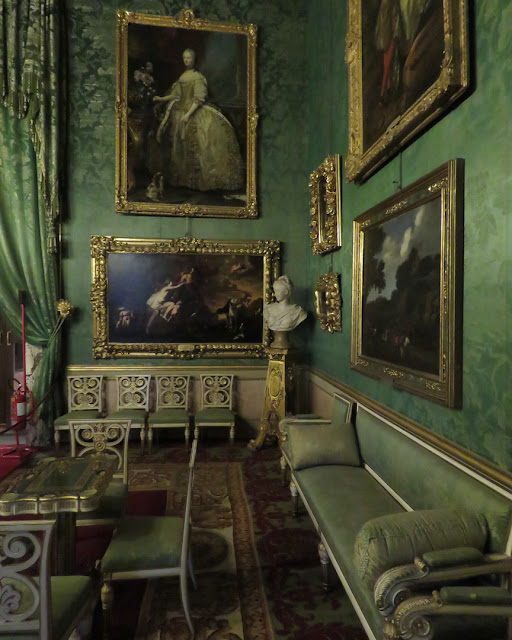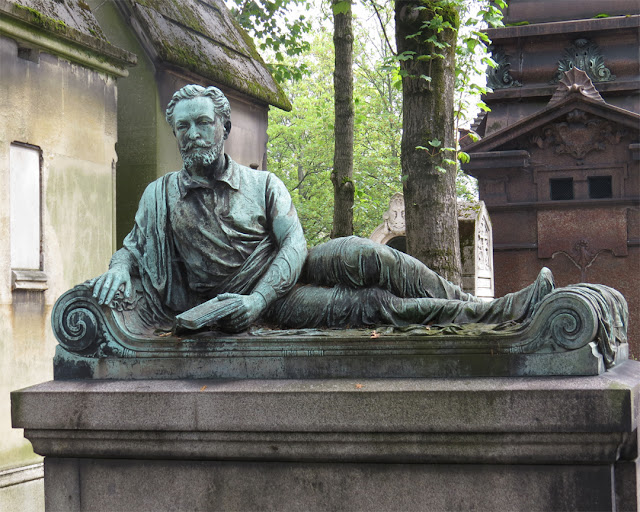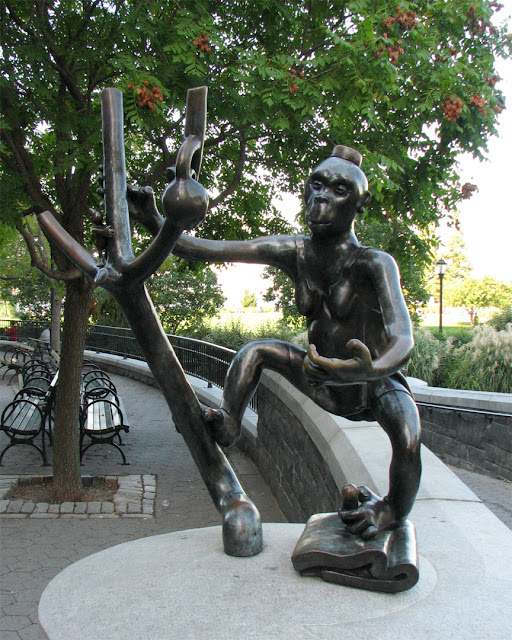Monday, August 31, 2020
Santa Maria in Ara Coeli
Santa Maria in Ara Coeli
Scala dell'Arce Capitolina
Rome, September 2019
“The Basilica of St. Mary of the Altar of Heaven (Latin: Basilica Sanctae Mariae de Ara coeli in Capitolium, Italian: Basilica di Santa Maria in Ara coeli al Campidoglio) is a titular basilica in Rome, located on the highest summit of the Campidoglio. It is still the designated Church of the city council of Rome, which uses the ancient title of Senatus Populusque Romanus. The present Cardinal Priest of the Titulus Sanctae Mariae de Aracoeli is Salvatore De Giorgi. The shrine is known for housing relics belonging to Saint Helena, mother of Emperor Constantine, various minor relics from the Holy Sepulchre, both the canonically crowned images of Nostra Signora di Mano di Oro di Aracoeli (1636) on the high altar and the Santo Bambino of Aracoeli (1897).” (Santa Maria in Ara Coeli, Wikipedia)
Sunday, August 30, 2020
Saturday, August 29, 2020
Jean-Baptiste Pezon
Grave of Jean-Baptiste Pezon and Adrien Pezon
Cimetière du Père-Lachaise, (Père Lachaise Cemetery)
Quartier du Père-Lachaise, 20th arrondissement
Paris, July 2014
Friday, August 28, 2020
Ponte Vecchio
Ponte Vecchio (Old Bridge)
Seen from the Ponte Santa Trinita (Holy Trinity Bridge)
Florence, January 2020
“The Ponte Vecchio (Old Bridge) is a medieval stone closed-spandrel segmental arch bridge over the Arno River, in Florence, Italy. It is noted for the shops built along it, as was once common. Butchers, tanners, and farmers initially occupied the shops; the present tenants are jewelers, art dealers, and souvenir sellers. The Ponte Vecchio's two neighboring bridges are the Ponte Santa Trinita and the Ponte alle Grazie. The bridge spans the Arno at its narrowest point where it is believed that a bridge was first built in Roman times, when the via Cassia crossed the river at this point. The Roman piers were of stone, the superstructure of wood. The bridge first appears in a document of 996 and was destroyed by a flood in 1117 and reconstructed in stone. In 1218 the Ponte alla Carraia, a wooden structure, was established nearby which led to it being referred to as ‘Ponte Nuovo’ relative to the older (Vecchio) structure. It was swept away again in 1333 except for two of its central piers, as noted by Giovanni Villani in his Nuova Cronica. It was rebuilt in 1345.” (Ponte Vecchio, Wikipedia)
Thursday, August 27, 2020
Wednesday, August 26, 2020
Tuesday, August 25, 2020
Arch of Janus
Arch of Janus
Via del Velabro
Rome, September 2019
“The Arch of Janus is the only quadrifrons triumphal arch preserved in Rome. It was set up at a crossroads at the northeastern limit of the Forum Boarium, close to the Velabrum, over the Cloaca Maxima drain that went from the Forum to the River Tiber. It was built in the early 4th century CE, using spolia, i.e. material from earlier buildings, including bricks, together with pottery shards, and was covered with white marble, also from earlier buildings. The exact significance of the arch is poorly understood: it is thought to have been a boundary marker rather than a triumphal arch. An alternative view is that it was built to provide shelter for the traders at the Forum Boarium cattle market. Some researchers believe it was dedicated to Constantine I or Constantius II and was known as the Arch of the Deified Constantine. It is 16 meters high and 12 meters wide.” (Arch of Janus, Wikipedia)
Monday, August 24, 2020
Sunday, August 23, 2020
Jan Twardowski
Jan Twardowski by Wojciech Gryniewicz, 2013
skwer im. ks. Jana Twardowskiego
Krakowskie Przedmieście
Warsaw, September 2018
“Jan Jakub Twardowski (1 June 1915 – 18 January 2006) was a Polish poet and Catholic priest. He was a chief Polish representative of contemporary religious lyrics. He wrote short, simple poems, humorous, which often included colloquialisms. He joined observations of nature with philosophical reflections.” (Jan Twardowski, Wikipedia)
Saturday, August 22, 2020
Count Luigi Pisani
Count Luigi Pisani by Augusto Rivalta, 1910
Galleria Palatina, Palazzo Pitti
Florence, January 2020
“Rivalta was born in Alessandria, Italy, to Genoese parents. In 1859, he moved to Florence, but soon swept up in the patriotic events, he volunteered for the Genovese Carabiniere, and took part in the campaigns. He was wounded during the conflict. He returned to Florence, where he studied with Aristodemo Costoli, and joined the studio of Giovanni Duprè. Among his first designs was for a monument to Count Cavour in Turin. While the jury sided with Rivalta, the commission was given to the more established Duprè. Rivalta's statue was placed in the courtyard of the Banca Nazionale in Florence.” (Augusto Rivalta, Wikipedia)
Friday, August 21, 2020
Thursday, August 20, 2020
Wednesday, August 19, 2020
Temple of Hercules Victor
Temple of Hercules Victor
Piazza della Bocca della Verità
Rome, September 2019
“The Temple of Hercules Victor (Hercules the Winner) or Hercules Olivarius is a Roman temple in Piazza Bocca della Verità, in the area of the Forum Boarium close to the Tiber in Rome, Italy. It is a tholos - a round temple of Greek 'peripteral' design completely encircled by a colonnade. This layout caused it to be mistaken for a temple of Vesta until it was correctly identified by Napoleon's Prefect of Rome, Camille de Tournon. Despite (or perhaps due to) the Forum Boarium's role as the cattle-market for ancient Rome, the Temple of Hercules is the subject of a folk belief claiming that neither flies nor dogs will enter the holy place. The temple is the earliest surviving marble building in Rome. The Hercules Temple of Victor is also the only surviving sacred temple in ancient Rome that is made of greek marble. Today it remains unsolved who this temple was dedicated for and for what purpose.” (Temple of Hercules Victor, Wikipedia)
Tuesday, August 18, 2020
Les femmes et les chiens
“Les femmes et les chiens” (The Women and the Dogs) by Nadir Afonso, 2010
Túnel do Estoril Sol
Cascais, April 2019
Monday, August 17, 2020
Sunday, August 16, 2020
Green Room
Green Room
Imperial and Royal Apartments
Palazzo Pitti (Pitti Palace)
Piazza de' Pitti
Florence, January 2020
“The Grand Dukes previously lived in the left wing of the palace, while the right was used by other members of the Medici family, the heirs first of all, such as Grand Prince Ferdinand, son of Cosimo III, who died young in 1713. In spite of successive changes, the Niche Room in that period was also used as a room to link the two wings, and the Green Room was the first room. It was known as the Guards Room in the time of Ferdinand, and then it became kind of antechamber with access into the actual apartment. The name comes from the green colour of the wall coverings, curtains and the upholstery on some of the furniture, which are all in silk - textured or plain, fitted by Florentine manufacturers between 1854 and 1855. In that period the room, like the two that follow it, was completely redecorated, earning the name of Quartiere delle Stoffe [Fabric District], and used first as a reception room, since the last Grand Duke, Leopold II of Lorraine had chosen the new Palazzina della Meridiana as his home. Also from the same period are the carpet, made by the prestigious Royal Works of Tournai, in northern France and decorated with late imperial motifs, the pair of lamps, the brackets for the candle holders, the fire guard and the fireplace mirror, carved in imitation of the two placed above the slightly older consoles. The rest of the furnishings and paintings come from different periods, starting with the canvas on the ceiling, the Allegory of Peace between Florence and Siena, painted for Cosimo III by Luca Giordano in 1682.” (Green Room, Le Gallerie degli Uffizi)
Saturday, August 15, 2020
Friday, August 14, 2020
Henri Léglise
Grave of Henri Léglise
Cimetière du Père-Lachaise, (Père Lachaise Cemetery)
Quartier du Père-Lachaise, 20th arrondissement
Paris, July 2014
Thursday, August 13, 2020
Sacro Cuore del Suffragio
Chiesa del Sacro Cuore del Suffragio
Lungotevere Prati
Rome, September 2019
“The Chiesa del Sacro Cuore di Gesù in Prati (Church of the Sacred Heart of Jesus in Prati), also known as Chiesa del Sacro Cuore del Suffragio (Church of the Sacred Heart of the Suffrage), is a catholic place of worship in the centre of Rome (Italy), rising in the rione Prati, hosting the parish with the same name, entrusted to the Missionaries of the Sacred Heart. In 1893, the Missionary of the Sacred Heart Victor Jouët, born in Marseille, founded in Rome the Associazione del Sacro Cuore del Suffragio delle Anime del Purgatorio (Association of the Sacred Heart of the Suffrage of the Purgatory Souls), having the aim to spread the worship to the Sacred Heart and to the Virgin Mary. The former oratory of the Association rose in Via dei Cosmati; a second one, used between 1896 and 1914, was located in Lungotevere Prati, into a ground that the founder had bought in order to build a bigger church, whose foundation stone was blessed in 1894 by Joseph-Jean-Louis Robert, Bishop of Marseille. The construction of the new church began in 1908 and the design was committed to engineer Giuseppe Gualandi, who chose a style inspired by French Gothic architecture. In 1914, the Association moved to the church of St. Joseph Calasanz in Via Cavallini, since the old chapel was partially demolished in order to allow the completion of the new church; the building, completed in 1917, was blessed and opened to worship on November 1 of the same year. The parish was founded on December 10. On May 17, 1921 the church was consecrated by Pietro Benedetti, Archbishop of Tyre, its first vicar. Pope John Paul II visited the church on February 1, 1998.” (Sacro Cuore del Suffragio, Wikipedia)
Wednesday, August 12, 2020
Tuesday, August 11, 2020
Tamino and Pamina
Tamino and Pamina from The Magic Flute (Mozartbrunnen or Zauberflötenbrunnen)
By Carl Wollek, on a design by Otto Schöntal, 1905
Mozartplatz
Vienna, June 2018
Monday, August 10, 2020
Saint Lawrence
Saint Lawrence by Gian Lorenzo Bernini, 1617
Contini Bonacossi Collection
Uffizi Gallery
Florence, January 2020
“The ‘Saint Lawrence’ of the Contini Bonacossi Collection is a work by the young Gian Lorenzo Bernini, in which it is possible to glimpse his mature style. It was completed in the same period as the ‘Saint Sebastian’ of the Thyssen-Bornemisza Collection and the influence of Michelangelo's work is evident in both sculptures. In particular, in ‘Saint Lawrence’ Bernini reinterprets the male nudes of the dead Christ in the ‘Pietà’ in Saint Peter's Basilica and the ‘River God’ of Casa Buonarroti in Florence, combining the state of abandonment of the first with the exasperated torsion of the other. Another undeniable model is the figure of Adam in the ‘Creation of Man’, on the vault of the Sistine Chapel. His reference to the figurative culture of the past, together with the technical skill and the focus on the expressions make Bernini one of the protagonists of the Baroque era. In the sculptor’s biography, his son Domenico says that during the realization of this sculpture, in order to depict the saint’s expression of pain on the rack, ‘he stood bare legged on one leg near smouldering ashes and thus experienced the martyrdom of the saint, while using a mirror and a pencil to draw the painful expression of his face, and observed the various effects that his own flesh underwent as a result of the heat of the flames’ (Vita del Cavalier Gio. Lorenzo Bernini, 1713). In fact, the saint’s face, relaxed and looking up, shows how it is possible to transcend pain through contact with God, as will happen in the later female figures of Saint Theresa in the ‘Ecstasy’ in the Cornaro Chapel in Santa Maria della Vittoria and the ‘Blessed Ludovica Albertoni’ in San Francesco a Ripa, both in Rome.” (Saint Lawrence, The Uffizi)
Sunday, August 9, 2020
Monkey with a tree
Monkey with a tree
“The Real World” by Tom Otterness, 1992
Nelson Rockefeller State Park
Battery Park City
New York, September 2007
Saturday, August 8, 2020
Friday, August 7, 2020
Waldensian Evangelical church
Waldensian Evangelical church
Piazza Cavour
Rome, September 2019
“The Waldensian Community has very ancient origins and is rooted in the religious movement of the ‘Poor Men of Lyon’, that at the end of the XII century predicted the return to a humble and poor church. They were present in Italy already during the XIII century, especially in Piedmont. The Waldensians became part of the Protestant Reform in 1532. In Rome they had a worshipping location since 1883 but in 1910 the engineer Emanuele Rutelli and the architect Paolo Bonci were charged of building a new temple. In 1913 the building was completed: first church of the capital with supporting structure in reinforced concrete, state of the art technology in those years. The style of the church is a mixture of neoromantic elements and Liberty. The façade with a cupola covering has two towers at each side and a cylinder covering each one of them: these cylinders look like small towers, connecting the building to the adjacent ones. The access door has a mosaic lunette on top with the symbol of the Waldensians: a bible on which a candelabra is placed, with a lighted candle, surrounded by the inscription lux lucet in tenebris (light illuminates the dark). Above the entrance there is a loggia and even more above you can admire a circular rose window. The interior part is divided into three naves and it is in Liberty style with frescos of very shiny colours and polychrome glass windows with symbolic pictures.” (Waldensian Evangelical Church, Jubilee Cultural Routes)
Thursday, August 6, 2020
Mulheres na Praia
“Mulheres na Praia” (Women on the Beach) by Nadir Afonso, 2010
Túnel do Estoril Sol
Cascais, April 2019
Wednesday, August 5, 2020
Baroque Pracownia
Baroque Pracownia Artystycznych Ram Stylowych, Paweł Remiszewski
Krakowskie Przedmieście
Warsaw, September 2018
Tuesday, August 4, 2020
Laocoon and His Sons
Laocoon and His Sons by Baccio Bandinelli
Galleria degli Uffizi (Uffizi Gallery)
Piazzale degli Uffizi
Florence, January 2020
“The monumental Laocoon Group, also called Laocoon and His Sons, by Baccio Bandinelli (Firenze 1493-1560) – from the Hellenistic original brought to light in Rome on 14 January, 1506 in the vineyard of Felice de Fredis, near Titus Thermae on the Opium Hill – depicts the Trojan priest Laocoon and his two sons ensnared in the toils of the sea serpents sent by Poseidon. In the original, that as recorded by Pliny the Elder in his Naturalis Historia had been made from one single block of marble, the priest’s right arm was missing, and Vasari’s Life of Baccio Bandinelli tells us he made an arm in wax to replace the lost one and used it as a model for his copy of the Laocoon, commissioned in 1520 by Pope Leo X de’ Medici as a gift to King Francis I. Baccio made his copy using three marble blocks. He decorated the pedestal front with a naturalistic open scroll with folding lines, and the sides with the emblem of pope Clement VII: a transparent globe crossed by a ray of sun that sets fire to a tree, and the pope’s motto ‘Candor illaesus’.” (Laocoon Group, Uffizi Gallery)
Monday, August 3, 2020
Monkey with feeding bottle
Monkey with feeding bottle
“The Real World” by Tom Otterness, 1992
Nelson Rockefeller State Park
Battery Park City
New York, September 2007
Sunday, August 2, 2020
Bóg, Honor, Ojczyzna
“Bóg, Honor, Ojczyzna” (God, Honour, Fatherland)
Church of St. Bernard of Siena
Bernardyńska
Stare Miasto (Old Town)
Kraków, September 2018
Saturday, August 1, 2020
Teatro Adriano
Teatro Adriano (Adriano Theater)
Piazza Cavour
Rome, September 2019
“The Teatro Adriano (Adriano Theater), also known as Politeama Adriano and Cinema Adriano, is a cinema and former theatre located in Piazza Cavour, Rome, Italy. It was built by Pio Gallas and Romeo Bisini on a project by architect Luigi Rolland (the father of Luigi Moretti) and inaugurated on 1 June 1898 with a representation of the Amilcare Ponchielli's opera La Gioconda conducted by Edoardo Mascheroni.” (Teatro Adriano, Wikipedia)
Subscribe to:
Posts (Atom)































